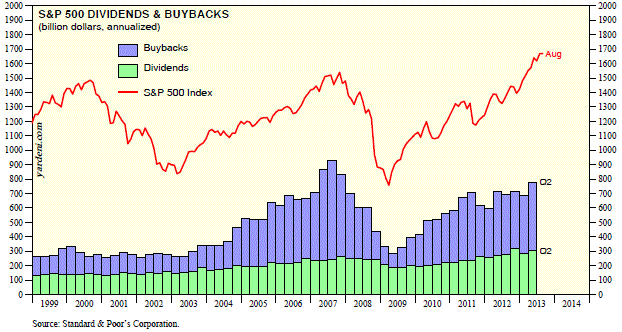A couple of charts circulating around the web this past week no doubt focused on the Fed's decision to continue QE unabated. Most economist and strategist believed the Fed would begin to taper even if the taper amount was a small amount. With the Fed's "no taper" decision, the S&P 500 Index shot higher immediately as noted in the below chart. The S&P was trading at 1,702 prior to the announcement and ultimately closed on the day at 1,725 or 1.35% higher.
 |
| From The Blog of HORAN Capital Advisors |
When the market achieves a new 52-week high on Fed announcement days, the below chart, highlighted by Andrew Thrasher, shows graphically the market's subsequent direction. In short, a sell off is not uncommon.
 |
| From The Blog of HORAN Capital Advisors |
Source: Andrew Thrasher
The immediate positive reaction to the Fed announcement most certainly has to do with the market's addiction to QE. Ed Yardeni notes the high correlation of the S&P 500 to Quantitative Easing. Yet he does point to several other influences that may be having a positive impact on the market, i.e., dividends and buybacks.
 |
| From The Blog of HORAN Capital Advisors |
Source: Yardeni Research, Inc.
H/T: The Kirk Report
Corporations have certainly enhanced their dividend and buyback policies. In large part this is not uncommon as the economy improves and corporations have excess cash to return to shareholders. At HORAN we have noted in a number of prior posts that we prefer an increasing dividend versus buybacks. Dividends are a longer term commitment on a company's part, where as a buyback can be reduced or go unfulfilled at any time by the company. Yardeni notes in the below chart these buybacks appear to be having a positive impact on the market as well.
 |
| From The Blog of HORAN Capital Advisors |
Source: Yardeni Research, Inc.
A concern we have with this elevated buyback activity is the fact companies have a history of buying back their stock at highs and not lows. In our earlier post, Stock Buybacks Do Not Benefit Future Stock Performance, we highlighted research from Thomson Reuters where the report noted, "...The negative correlation between repurchases and forward returns shows that most buybacks did not pay off within the year after purchase."
As the second chart above shows, the market has a tendency to move higher subsequent to these pullbacks. For many investors market timing is a difficult endeavor. A key point is for investors to evaluate their holdings to ensure their asset allocation is one they are comfortable with in the event the market does sell off.

No comments :
Post a Comment